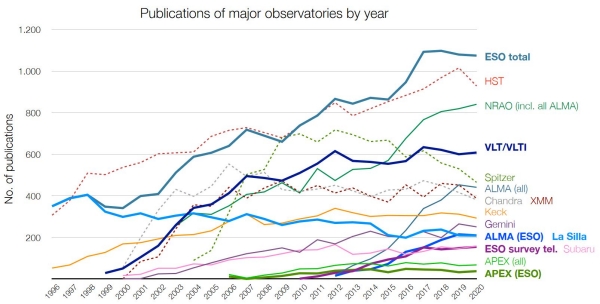ESO observatories operated under challenging conditions in 2020 due to the COVID-19 pandemic, having to reduce and even pause scientific observations for a few months. Nonetheless, 2020 was still a very productive year with regard to the number of papers that were published using data from ESO telescopes, mostly obtained in previous years. A recently published report from the ESO library shows that 2020 represents the fourth consecutive year that over 1000 scientific studies using ESO data were published. The majority of these publications used data from ESO’s flagship facility, the Very Large Telescope (VLT), and the VLT Interferometer (VLTI).
Over 1000 Studies Using ESO Data: a Look Back at ESO’s Science Results of 2020

Of the more than 600 studies carried out using observations from the VLT and VLTI, 55% used data from the Multi Unit Spectroscopic Explorer (MUSE), the Ultraviolet-Visual Echelle Spectrograph (UVES), or from the X-shooter spectrograph. These were the three most productive VLT instruments in 2020, as was the case in 2019. Data from the survey telescopes at ESO’s Paranal Observatory, the Visible and Infrared Survey Telescope for Astronomy (VISTA) and the VLT Survey Telescope (VST), led to over 150 published papers in 2020, in line with previous years.
Approximately 200 papers were published using data obtained from ESO’s oldest observatory, La Silla. Of these, a significant portion (122) came from the High Accuracy Radial velocity Planet Searcher (HARPS), an instrument mounted on ESO’s 3.6-metre telescope that is dedicated to the search for, and study of, exoplanets.
The Atacama Large Millimeter/submillimeter Array (ALMA) provided data for over 440 papers. Almost half (48%) of these used data obtained during European ALMA time. ESO is also a partner in the Atacama Pathfinder Experiment (APEX). In 2020, observations obtained during ESO observing time at APEX contributed to more than half (56%) of papers from all APEX observing time.
For the second year running, more than a third (36%) of all ESO data papers published in 2020 used observations that came partly or exclusively from the ESO Science Archive.
Comparing publication statistics for ESO and other observatories is complicated by the fact that different institutes use different methods to count scientific studies; nonetheless, ESO has remained the world’s most productive ground-based observatory in 2020, with over 1000 papers published using ESO data. The figures are published in the annual Basic ESO Publication Statistics published by ESO’s Library and Information Centre and calculated using the ESO Telescope Bibliography (telbib), a database containing refereed publications that use ESO data. ESO makes extensive efforts to identify all refereed papers that use ESO data and considers telbib essentially complete.
Interactive graphs of selected statistics are available online. These graphs display the entire content of the telbib database, which contains records for publications from 1996 to the present. They can be used to explore many aspects of the publication history, including the development of science papers using data from ESO instruments and the use of archival data.
